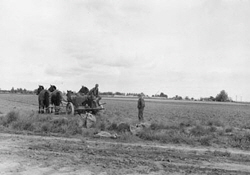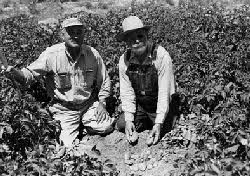See also: The Modern Potato; Potatoes Early History;
The Idaho Potato The Growth of the Potato Industry in IdahoOf utmost importance to the potato industry was the discovery of gold in Idaho in 1860. Much of the early potato production was used to feed miners and fields of potatoes were grown to accommodate the men in lead, gold and silver camps.
As early as 1875, the Mormons were shipping potatoes to California. The Deseret Evening News of December 2, 1875, reprinted an article from the San Francisco Chronical titled "Brigham's Potatoes":
"That the farmers of Utah (and Idaho) can hope to compete with the potato raisers of this state, when the rates of freight are taken into consideration, would seem absurd were it not for the fact that the ‘co-op' is the parent of an innumerable number of little ‘co-ops' scattered all through the Territory, and that the whole is connected and banded with the Church government in such a manner as to give the main institution peculiar facilities for gathering cheaply the products of Utah (and Idaho) soil. 
"...Over 2,000 sacks have already reached this city, and 100 car loads more, sixty of which are on the way, are coming. The potatoes are known as the Neshannock, and it is, of course, claimed that they possess some particular excellence which those of California growth lack."
Again on January 20, 1876, Deseret Evening News reported:
"During the past season Z.C.M.I. (Zion's Co-operative Merchantile Institution) shipped to San Francisco, California - 2,571,466 pounds of potatoes, which cost, delivered at Ogden, $23,045.10. This is a fair commencement, being but the inaugural season of the potato trade with California. This branch of exportation to California was solely conducted by Z.C.M.I., no other house having engaged in it."
Early Idaho newspapers encouraged growing potatoes and the Idaho Tri-Weekly Statesman of October 27, 1881, even went so far as to suggest "evaporation" so that fruit and vegetables could "reduce to one-fourth of their original bulk and lower the cost of hauling the product to markets."
"A bushel of potatoes weighs sixty pounds," the newspaper states, "and by this process (evaporation) it can be condensed to thirteen pounds at an expense of about nine cents per bushel. At present it costs two cents per pound to haul a bushel of potatoes from Boise City to Hailey, a distance of 144 miles. This is $1.20 per bushel. But if you evaporate the water and condense your bushel of potatoes into thirteen pounds of bulk, your freight is but twenty-six cents or a clear savings of eighty-five cents upon your bushel of potatoes." 
The spread of potato agriculture in eastern Idaho was only a matter of time. Henry E. Jenkins was a freighter, hauling cargo from Lorrine, Utah, to Virginia, Montana, with teams of oxen in 1870. As reported by his daughter, Mrs. John A. Rassmussen of Idaho Falls, in the spring of that year Jenkins hauled a load of potatoes from Farmington, Utah, to Blackfoot, Idaho. The recipient of the shipment was Judge Stephens, who was encouraged by the freighter to plant the potatoes believed to be the first planting in the Blackfoot area. At that time, Idaho Falls was known as Eagle Rock, and a man named John Anderson had build a toll bridge across the Snake River which was utilized by Jenkins in his freighting operation. Jenkins was apparently on hand in the fall when the potatoes were harvested and reported that they were "as hard as rocks." In spite of this apparent lack of quality in the first crop planted in the Blackfoot area, it did not discourage the early farmers as additional plantings were made in the vicinity. More and more potatoes were planted and the Blackfoot area has grown now into one of the principal potato producing areas in Idaho.
The United States Department of Agriculture estimates were first made for the state of Idaho in 1882 and that year they recorded that 2,000 acres were harvested at the average price of $1.67. The total value of the potato market in Idaho that first year was $250,000. It was in 1904 when the value of potatoes in Idaho went over the million mark with $1,328,000.
In 1890 Idaho was admitted to the Union as the forty-third state. And by fall of 1890 Idaho potatoes were becoming well known in produce circles. Frank Drake of Hailey was awarded $125 as a prize for the third heaviest yield of one acre of potatoes in the United States! Drake was a prominent rancher living just out of Hailey and he also developed a seed potato which was claimed to be the "most prolific known."
And then came the news that Thomas Wend of Shoup had received a $100 award offered by a Philadelphia seed dealer for the heaviest potatoes raised from seed purchased from him in 1890. The six potatoes weighed 17 pounds. Visit the official website of the Idaho Potato: www.idahopotato.com
| 